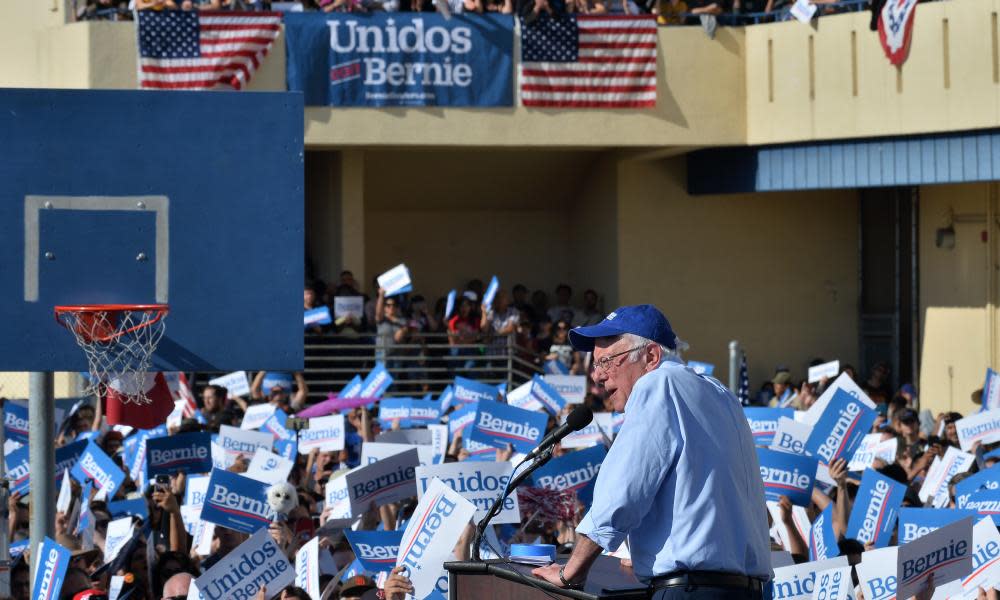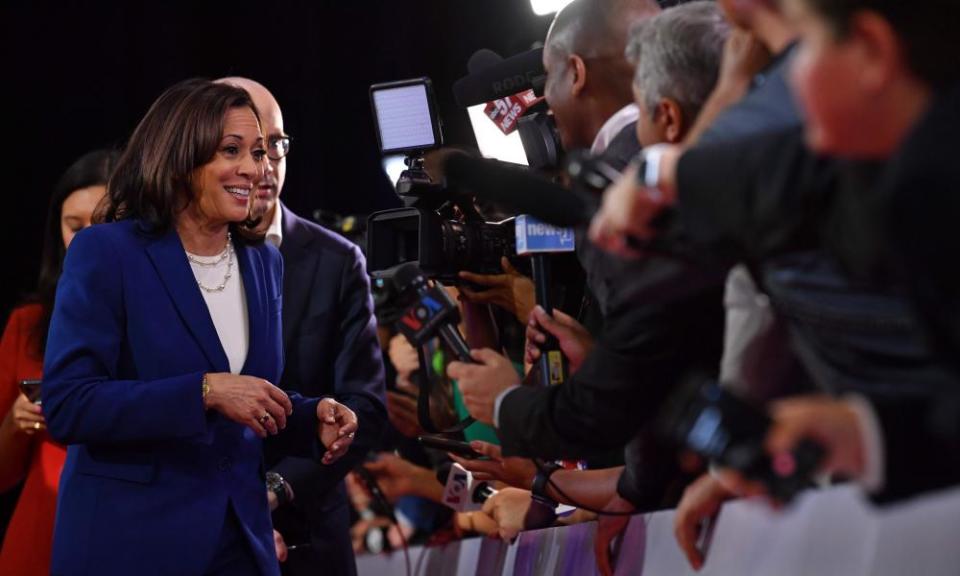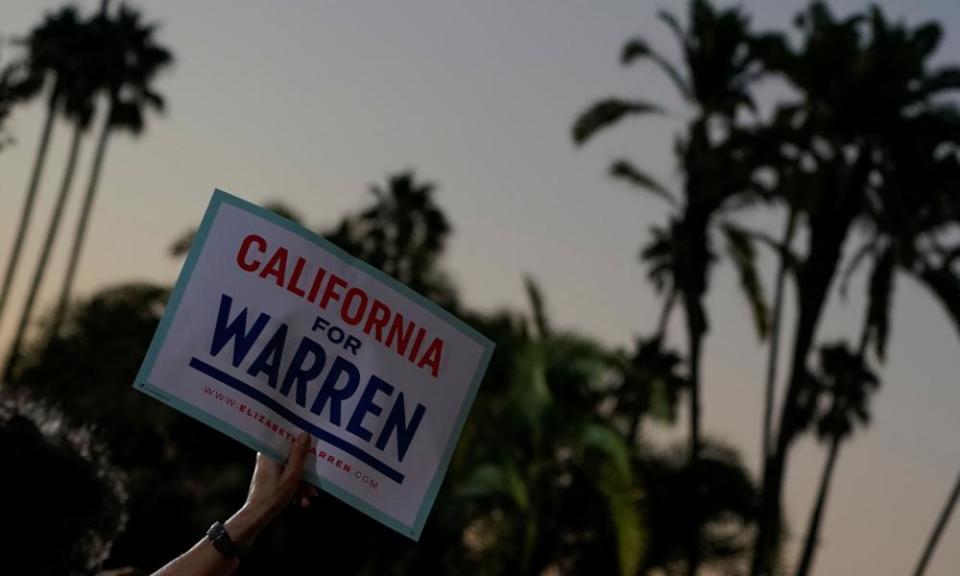Once a glorified ATM for Democrats, California becomes major player in election race

California is America’s richest and most populous state and a political heavyweight by any measure. But for more than 30 years – ever since its adopted son Ronald Reagan rode off from the Oval Office into a golden Pacific sunset – it has yearned for relevance in presidential elections and largely failed to find it.
That is, until now.
Related: Welcome to California: 10 things every 2020 presidential hopeful should know
In a highly fluid 2020 race for the Democratic party nomination, candidates participating in Thursday’s debate in Los Angeles have packed their schedules with campaign appearances all over the Golden State in the days before and after. They are opening California field offices at a frenetic pace, falling over each other to hire the state’s most talented campaign staffers, and laying the groundwork for big, expensive advertising buys in the final weeks before the state’s 3 March primary.
All of this is highly unusual in a state that most candidates, Republican and Democrat alike, tend to treat like a glorified ATM – a place to woo donors and raise money to be spent elsewhere. An unassailably blue state with a primary late in the election cycle is not worth the cost of its unusually expensive media markets, the rationale once went.
This year, though, California has moved its primary up by three months to Super Tuesday. And its trove of delegates is especially attractive as the three Democratic frontrunners – Joe Biden, Bernie Sanders and Elizabeth Warren – are within spitting distance of each other and a fourth, Pete Buttigieg, is likely to enjoy considerable momentum coming out of the earlier contests in Iowa and New Hampshire.
Add to that the large number of state endorsements up for grabs now that the California Senator Kamala Harris has left the race, and the wrench thrown into everyone’s calculations by the late entry of Michael Bloomberg, the billionaire former mayor of New York who is spending lavishly on advertising and consultants, and it becomes apparent that California has flipped from a state everyone can safely ignore to one nobody can afford to bypass.
“There’s a tremendous amount at stake,” Buttigieg spokeswoman Tessa Whittlesey told the Guardian.
California campaigning is not for the faint-hearted. Candidates win delegates if they snag at least 15% of the statewide vote, and 15% of the vote in any one of the state’s 53 congressional districts. In other words, they don’t just have to campaign – they have to campaign everywhere.
As the field thins, California is only going to become more important
Raphael Sonenshein
“It’s helpful to think of California as a country more than a state,” said Raphael Sonenshein, a political analyst who last month hosted a Democratic candidates’ forum at Cal State Los Angeles, where he runs a public affairs institute. “We have regions as complex as a small country’s, and a lot of delegates. As the field thins, California is only going to become more important.”
The early advantage probably goes to Sanders, who was narrowly ahead in a recent statewide poll and has had a staffed operation in California since June. He had 10 offices up and down the state at last count – far more than anyone else – and expects to have 15 by the turn of the year. Bernie 2020 volunteers have opened up their own storefront operations in working-class and hipster neighborhoods alike.
Sanders started this week in the desert communities around Palm Springs, attracting noisy crowds and the endorsement of the entire council in the small city of Coachella. He will end it on the Mexican border south of San Diego. He lost the 2016 California primary to Hillary Clinton, but by a margin narrow enough that Clinton felt compelled to hire 40 staffers in the last two months for what was not ultimately the pivotal race.
Closest to Sanders in energy and activity is Buttigieg, who has visited California dozens of times and has made a point of appearing in rural and inland areas, not just the state’s fundraising meccas, LA and San Francisco. His state director, Cecilia Cabello, is a California insider with experience of both big city and presidential politics. As his campaign staffs up, he’s establishing volunteer networks in every congressional district.

Buttigieg and Sanders both appear to have understood that much in the race may turn on their ability to refresh parts of the state that the other candidates, running on TV ads and name recognition alone, fail to reach.
The Sanders spokeswoman Anna Bahr said the campaign’s staff offices were designed to target Latinos, in particular, and working-class communities in general. Two of the newer offices are in California’s agricultural Central Valley, and the campaign is also focusing on the sprawl of inland suburbs stretching 60 or 70 miles east of Los Angeles.
Buttigieg, meanwhile, has been active in the Central Valley for a while. He held a low-dollar fundraiser in Sacramento, the state capital, last June that attracted 2,500 people. And this week he will take the fight directly to Sanders as he talks about Latino issues and the environment in two contrasting LA suburbs.
There is a chance that none of this activity will make much difference come election day. When California moved its primary up to March, legislators entertained the notion that they would now be fifth in line after Iowa, New Hampshire, Nevada, and South Carolina. But Texas, another huge state, quickly followed suit, and so did Virginia, Colorado and 10 other states, all of whom will be competing for candidate time and campaign cash on an unusually “super” Super Tuesday.
That might explain why Warren and Biden, who can count on a strong following in California whether they campaign here or not, have kept their powder relatively dry to this point. An argument can still be made that since the delegates will be split in California anyway, it is not a state that represents good return on investment.

Another big unknown is Bloomberg. There is little evidence, yet, that he commands much in the way of public support, in California or anywhere else, but he has stunned some of the other campaigns by scooping up political consultants and managers they had been vying to hire and earning endorsements from mayors he knows through his extensive work with cities on the environment and other issues. On a recent swing through California, he appeared with former governor (and three-time presidential candidate) Jerry Brown – a coup for any candidate that he pulled off with little apparent effort.
The pressure is evident in the sniping that has begun among the candidates on the campaign trail. On Monday night, Sanders sought to contrast his refusal to take money from big donors with the fundraising dinner that Buttigieg was attending that night. The Buttigieg camp countered that they too had raised a lot of money from small donors paying as little as $25 to attend events like the Sacramento dinner.
Sanders, in turn, has been accused of spreading himself wide but thinly in California. Critics say the noise generated by his appearances is not always matched by staff efforts to form relationships with new groups of voters and work to turn them out on election day. Spokesperson Bahr swiftly dismissed this. “You can’t accuse of us of being shallow when we’ve invested more than anyone else in this state,” she said.
This article was amended on 19 December 2019 to reflect that Cecilia Cabello is not the only native Californian state director in the race.

